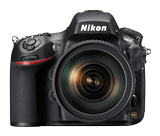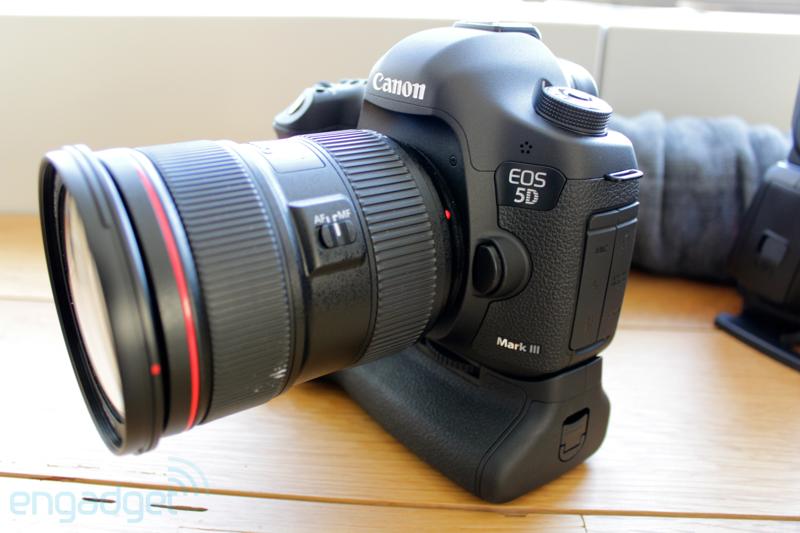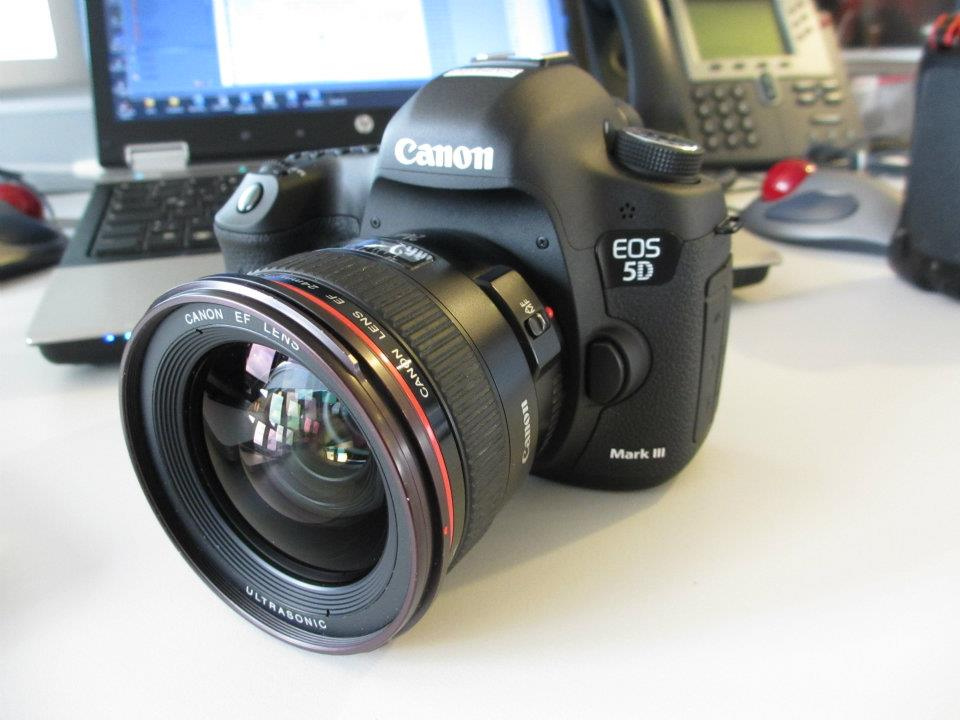If you like this post, help us share it
Canon has revealed the highly anticipated Canon EOS-5D III (B&H). It is equipped with a full-frame 22.3 Megapixel CMOS sensor and a new DIGIC 5+ Image Processors deliver high quality image capture at up to 6 fps and a powerful ISO range of 100 – 25600 (up to 102400 in H2 mode). It has a higher MP than the Canon 1D-X (B&H) The EOS-5D III uses the same 61-Point AF system and 100,000-pixel RGB Metering Sensor as Canon’s flagship DSLR EOS-1D X. This is a huge AF improvement over the EOS-5D II with 4x more AF points. ISO on the EOS-5D III also gets a 2 stops improvement, it even has a wider ISO range than the Nikon D800. The EOS-5D III received an improved HD video capability which can now record up to 29mins 59secs at 1080: 30fps. 60fps on 720p is now also possible on the 5D III. Durable construction with Magnesium alloy body and shutter durability tested to 150,000 cycles make this a robust camera. Unfortunately, I am not a Canon User thou.
You can pre-order your Canon EOS-5D III at B&H.

Front and back view of Canon’s new EOS-5D III


Canon EOS-5D III new features explained

22.3 Megapixel full-frame CMOS sensor
The EOS 5D Mark III features a newly developed Canon full-frame 22.3 Megapixel CMOS sensor. A full 24 x 36mm, the sensor captures 5784 x 3861 large individual 6.25 µm pixels and has a much-improved S/N ratio resulting in better images from the start. A new photodiode structure with an increased photoelectric conversion rate increases the sensor’s sensitivity by approximately 2 stops over previous models. And a 2-line 8-channel simultaneous signal readout means speeds of up to 6.0 fps (RAW + JPEG) are possible!
14-bit A/D conversion, wide range ISO setting 100-25600 (L: 50, H1: 51200, H2: 102400)
The EOS-5D III not only offers 14-bit signal processing for excellent image gradation, it delivers higher standard and expanded ISOs. With a standard range of ISO 100-25600 (up to 102400 on H2), the EOS 5D Mark III represents a 2-stop increase in sensitivity over previous cameras.

DIGIC 5+ Image Processors for enhanced noise reduction and blazing processing speed
The EOS 5D Mark III uses a DIGIC 5+ Image Processors that include four 4-channel A/D converter front-end processing circuits and deliver speeds of up to 6 fps (RAW + JPEG).
Canon’s flagship 1D X uses dual DIGIC 5+ image processors to deliver an amazing 12 FPS.
The DIGIC 5+ Image Processor improves data processing performance and features new algorithms that promote greater noise reduction at higher ISOs. In addition to conventional image processing functions the DIGIC 5+ Image Processor offers real-time compensation for chromatic aberration in both still and motion images. With the power of this processor, speed improvements are noticeable from the instant the camera is turned on and the stunning results speak for themselves.

All new 61-Point High Density Reticular AF
Similar to the Canon 1D X, the newly designed 61-Point High Density Reticular AF features an Offset Array Sensor (with staggering AF point arrangement). It offers multi-zone wide-area AF for better tracking, has 5 central dual cross-type points (f/2.8 diagonal), 21 central cross-type points (f/5.6 horizontal & vertical) and 20 outer cross-type points (f/4.0 horizontal), and is sensitive in extremely low-light situations (EV-2 for a central point with a f/2.8 lens).
The EOS 5D Mark III has a dedicated AF menu tab, so AF can be controlled without having to go through custom function menus. It also has 6 AF point selection methods (Spot, Single Point, Single + Adjacent 4 Points, Single + Adjacent 8 Points, Zone Selection, and Automatic AF Point Selection), plus a dedicated AF configuration tool for control of AI Servo AF III tracking parameters (tracking sensitivity, acceleration/deceleration tracking, and AF point auto switching).
The 5D III features Canon’s multi-layer 63-zone iFCL (intelligent Focus Color Luminance) Metering System that integrates the cameras AF system into its readings. By taking into account the color and luminosity surrounding the chosen AF point(s), this delivers an entirely new level of accuracy, especially in situations where the light changes quickly.
All 61 AF points of the Canon 5D III are usable with every Canon lens of f/5.6 or faster. Refer to diagrams below:



(1) (2) (3)
(1) All 61 AF points of the Canon 5D III are usable with every Canon lens of f/5.6 or faster. Of the 61 AF points, 41 are cross typed sensors with aperture f/4 or brighter and 5 double across type with f/2.8 or brighter
(2) 41 cross type focus points are compatible with aperture between f/2.8 and f/4
(3) 21 cross type central focus points are compatible with f/5.6

Shutter Durability for up to 150,000 cycles
Its newly redesigned shutter has lightweight and carbon-fiber blades, and is rated to maintain up to 6 fps performance without compromise, for up to 150,000 cycles. The EOS-5D III X does not seem to have an electronic first curtain.

Magnesium Ally Body, Dual Card Slots and 3.2” TFT LCD Monitor
The EOS-5D III is constructed of rigid, high-strength magnesium alloy for rugged performance and features a new grip design for easier finger placement and reduced hand fatigue.
The EOS-5D III records to CompactFlash and SD cards and features Dual Card Slots.
The EOS-5D III’s 3.2" TFT LCD monitor has 1,040,000 dots, anti-reflective construction and features Canon’s Clear View II technology.

HD Movie
The EOS 5D Mark III captures HD video on par with professional movie cameras. It offers both All-I and IPB compression, supports H.264/MPEG-4 AVC High Profile, and automatically splits files greater than 4GB (FAT specifications) for extended recording without interruption. It offers the option of timecoding during recording only (Rec Run) or at all times (Free Run). The CMOS sensor’s new drive system significantly increases image processor performance, reducing color artifacts and moiré (a common problem that occurs in scenes with horizontal lines), and ensures that the EOS 5D Mark III can record at a number of frame rates up to ISO 25600 in H mode. The EOS 5D Mark III delivers 1080p recording in 24/25/30 FPS and 720p in 60 FPS. It is still missing recording 1080p in 60 FPS.
The Canon EOS 5D III is starting to ship at the end of March 2012. The expected U.S. street price has been set at US$3500. You can pre-order yours at B&H.
Side by Side comparison
Here are a side by side comparison with the 5D II and D800.
From the front, you will notice a much more contoured hot shoe bonnet which I feel it looks much better. At the back, the on/off switch is not located next to the mode dial. The mic is now placed at the bottom left corner instead. A video record start/stop button is placed at the thumb position. The LCD got wider by 0.2 of an inch. The Canon still doesn’t have a zoom out button which is something I still can’t get use to.
Viewing from the top, there is not much difference, except there is a M-fn button located next to the shutter button.



Here is a much more interesting side by side comparison with the Nikon D800 which should show the very much different ergonomic design strategy that Canon and Nikon employ. From the front, Nikon places one of their dial at the front of the grip. This has always been the case and I feel this is a better design. The Nikon also has some of its ports placed at the front . The hot shoe bonnet is more contoured on the 5 D III design. The 5D III has the on/off which on the left hand side next to the mode dial which means you will need another hand to turn it on. Nikon has the on/off switch moulded with the shutter button. You can turn it on using one hand only.
On the back, Canon offers a nice large dial for changing settings and menu scrolling. Canon uses a small joystick to control the AF points whereas Nikon uses a joypad to control the AF points.
From the top, Nikon’s hot show bonnet extends a little bit further out than Canon’s. This is because the D800 has a built in flash and the 5D III doesn’t. Canon has also placed various buttons close to the shutter button. Nikon does not offer a mode dial for their pro DSLR series, instead, it is replaced by a dial used for changing the settings for ISO/BKT/QUAL/WB.



source: dpreivew
Here is a Canon 5D III vs 5D II vs 1D x vs D800 Specification Comparison
|
|
Canon 5D III |
Canon 5D II |
Canon 1D X |

Nikon D800 |
|
Effective Pixels |
22.3 megapixels |
21.1 megapixels |
18.1 megapixels |
36.3 million |
|
Image Sensor Format |
FX |
FX |
FX |
FX |
|
File Format Still Images |
(1) Large: Approx. 22.10 Megapixels (5760 x 3840) (2) Medium: Approx. 9.80 Megapixels (3840 x 2560) (3) S1 (Small 1): Approx. 5.50 Megapixels (2880 x 1920) (4) S2 (Small 2): Approx. 2.50 Megapixels (1920 x 1280) (5) S3 (Small 3): Approx. 350,000 Pixels (720 x 480) (6) RAW: Approx. 22.10 Megapixels (5760 x 3840) (7) M-RAW: Approx. 10.50 Megapixels (3960 x 2640) (8) S-RAW: Approx. 5.50 Megapixels (2880 x 1920) |
(1) Large/Fine: Approx. 6.1MB (5616 x 3744 pixels) |
(1) Large: Approx. 17.9 Megapixels (5184 x 3456) |
JPEG: JPEG-Baseline Compliant with fine (approx 1:4), Normal (approx 1:8) or Basic (approx 1:16) Compression |
|
Card Slot |
1 CompactFlash© (CF) card and 1 SD memory type card |
1 CompactFlash© (CF) card |
2 CompactFlash© (CF) cards |
1 CompactFlash© (CF) card and 1 SD memory type card |
|
Viewfinder Frame Coverage |
100% vertically and horizontally (At approx. 21mm eyepoint) |
98% |
Vertical/Horizontal approx. 100% |
100% |
|
Viewfinder Magnification |
0.70x Approx. |
0.70x Approx. |
0.70x Approx. |
0.70x Approx. |
|
Fastest Shutter Speed |
1/8000 sec. |
1/8000 sec. |
1/8000 sec. |
1/8000 sec. |
|
Slowest Shutter Speed |
30 sec. |
30 sec. |
30 sec. |
30 sec. |
|
Top Continuous Shooting Speed at full resolution |
6 frames per second |
3.9 frames per second |
14 frames per second |
6 frames per second |
|
Exposure Compensation |
±5 EV in increments of 1/3, 1/2 or 1 EV |
±5 EV in increments of 1/3, 1/2 or 1 EV |
±5 EV in increments of 1/3, 1/2 or 1 EV |
±5 EV in increments of 1/3, 1/2 or 1 EV |
|
Mirror Lock Up |
Yes |
Yes |
Yes |
Yes |
|
ISO Sensitivity |
ISO 200 – 25600 |
ISO 100 – 6400 |
ISO 200 – 51200 |
ISO 100 – 6400 |
|
Maximum Autofocus Areas/Points |
61 (41 cross type at f/5.6) |
9+6 AF Points (1 cross type at f/5.6) |
61 AF Points (41 cross type at f/5.6) |
51 focus points (15 cross-sensors at f/8) |
|
Top FP High Speed Sync |
Up to 1/8000 |
Up to 1/8000 |
Up to 1/8000 |
Up to 1/8000 |
|
Flash Compensation |
-3 to +1 EV in increments of 1/3, 1/2 or 1 EV |
-3 to +1 EV in increments of 1/3, 1/2 or 1 EV |
-3 to +1 EV in increments of 1/3, 1/2 or 1 EV |
-3 to +1 EV in increments of 1/3, 1/2 or 1 EV |
|
Movie |
HD 1,920×1,080 / 30 fps |
HD 1,920×1,080 / 30 fps |
HD 1,920×1,080 / 30 fps |
HD 1,920×1,080 / 30 fps |
|
Monitor Size |
3.2” 1040k dot |
3.0” 921k dot |
3.2” 1040k dot |
3.2” 921k dot |
|
Approx. Dimensions |
152 x 116 x 76mm |
152 x 113.5 x 75 mm |
157 x 162 x 83 mm |
144.8 x 122 x 81 mm |
|
Approx. Weight |
900g (Body only)
|
810g (Body only)
|
1530g (Body only)
|
1000g (Body only) |
| Price | $3500 USD | $2499 USD | TBC | $2999 USD |
Check out some actual Canon EOS-5D III hands on photos from engadget.




Where can I find the equipment seen on this site?
If you find this site useful and planning to purchase any of the equipment seen on this site, please show your support by purchasing your photo equipment at B&H Photo Video, or through any of the affiliate links seen on this site.





